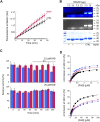Yin and Yang in Post-Translational Modifications of Human D-Amino Acid Oxidase
- PMID: 34041270
- PMCID: PMC8141710
- DOI: 10.3389/fmolb.2021.684934
Yin and Yang in Post-Translational Modifications of Human D-Amino Acid Oxidase
Abstract
In the central nervous system, the flavoprotein D-amino acid oxidase is responsible for catabolizing D-serine, the main endogenous coagonist of N-methyl-D-aspartate receptor. Dysregulation of D-serine brain levels in humans has been associated with neurodegenerative and psychiatric disorders. This D-amino acid is synthesized by the enzyme serine racemase, starting from the corresponding L-enantiomer, and degraded by both serine racemase (via an elimination reaction) and the flavoenzyme D-amino acid oxidase. To shed light on the role of human D-amino acid oxidase (hDAAO) in D-serine metabolism, the structural/functional relationships of this enzyme have been investigated in depth and several strategies aimed at controlling the enzymatic activity have been identified. Here, we focused on the effect of post-translational modifications: by using a combination of structural analyses, biochemical methods, and cellular studies, we investigated whether hDAAO is subjected to nitrosylation, sulfhydration, and phosphorylation. hDAAO is S-nitrosylated and this negatively affects its activity. In contrast, the hydrogen sulfide donor NaHS seems to alter the enzyme conformation, stabilizing a species with higher affinity for the flavin adenine dinucleotide cofactor and thus positively affecting enzymatic activity. Moreover, hDAAO is phosphorylated in cerebellum; however, the protein kinase involved is still unknown. Taken together, these findings indicate that D-serine levels can be also modulated by post-translational modifications of hDAAO as also known for the D-serine synthetic enzyme serine racemase.
Keywords: D-serine; biochemical properties; flavoprotein; nitrosylation; phosphorylation; sulfhydration.
Copyright © 2021 Sacchi, Rabattoni, Miceli and Pollegioni.
Conflict of interest statement
The authors declare that the research was conducted in the absence of any commercial or financial relationships that could be construed as a potential conflict of interest.
Figures




Similar articles
-
Structure-function relationships in human d-amino acid oxidase variants corresponding to known SNPs.Biochim Biophys Acta. 2015 Sep;1854(9):1150-9. doi: 10.1016/j.bbapap.2015.02.005. Epub 2015 Feb 17. Biochim Biophys Acta. 2015. PMID: 25701391
-
The degradation (by distinct pathways) of human D-amino acid oxidase and its interacting partner pLG72--two key proteins in D-serine catabolism in the brain.FEBS J. 2014 Feb;281(3):708-23. doi: 10.1111/febs.12616. Epub 2013 Dec 10. FEBS J. 2014. PMID: 24237903
-
Biochemical Properties of Human D-Amino Acid Oxidase.Front Mol Biosci. 2017 Dec 15;4:88. doi: 10.3389/fmolb.2017.00088. eCollection 2017. Front Mol Biosci. 2017. PMID: 29326945 Free PMC article.
-
Biochemical Properties of Human D-amino Acid Oxidase Variants and Their Potential Significance in Pathologies.Front Mol Biosci. 2018 Jun 12;5:55. doi: 10.3389/fmolb.2018.00055. eCollection 2018. Front Mol Biosci. 2018. PMID: 29946548 Free PMC article. Review.
-
Competitive Inhibitors Unveil Structure/Function Relationships in Human D-Amino Acid Oxidase.Front Mol Biosci. 2017 Nov 27;4:80. doi: 10.3389/fmolb.2017.00080. eCollection 2017. Front Mol Biosci. 2017. PMID: 29250527 Free PMC article. Review.
Cited by
-
Triiodothyronine acts on DAO to regulate pulmonary fibrosis progression by facilitating cell senescence through the p53/p21 signaling pathway.Front Pharmacol. 2024 Sep 11;15:1433186. doi: 10.3389/fphar.2024.1433186. eCollection 2024. Front Pharmacol. 2024. PMID: 39323641 Free PMC article.
-
On the regulation of human D-aspartate oxidase.Protein Sci. 2023 Nov;32(11):e4802. doi: 10.1002/pro.4802. Protein Sci. 2023. PMID: 37805834 Free PMC article.
References
LinkOut - more resources
Full Text Sources
Other Literature Sources
Molecular Biology Databases

